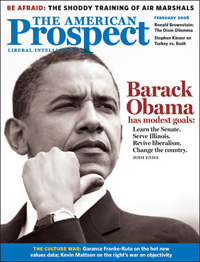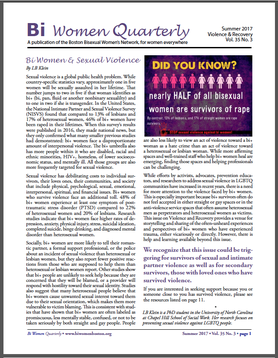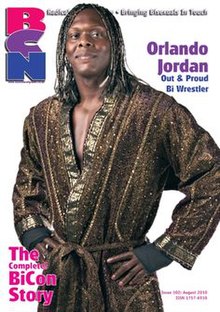
A fanzine is a non-professional and non-official publication produced by enthusiasts of a particular cultural phenomenon for the pleasure of others who share their interest. The term was coined in an October 1940 science fiction fanzine by Russ Chauvenet and first popularized within science fiction fandom, and from there the term was adopted by other communities.

The American Prospect is a daily online and bimonthly print American political and public policy magazine dedicated to American modern liberalism and progressivism. Based in Washington, D.C., The American Prospect says it "is devoted to promoting informed discussion on public policy from a progressive perspective." Its motto is "Ideas, Politics, and Power".
Queercore is a cultural/social movement that began in the mid-1980s as an offshoot of the punk subculture and a music genre that comes from punk rock. It is distinguished by its discontent with society in general, and specifically society's disapproval of the LGBT community. Queercore expresses itself in a DIY style through magazines, music, writing and film.

The Council for British Archaeology (CBA) is an educational charity established in 1944 in the UK. It works to involve people in archaeology and to promote the appreciation and care of the historic environment for the benefit of present and future generations. It achieves this by promoting research, conservation and education, and by widening access to archaeology through effective communication and participation.
The UK BiCon, is the largest and most consistent annual gathering of the United Kingdom's bisexual community.
International Association of Teachers of English as a Foreign Language (IATEFL) is an organisation in the field of English language learning and teaching. It is based in Britain and was founded in 1967 as ATEFL, by W. R. (Bill) Lee, who also served as the organisation's first Chairman until 1984.
The bisexual community, also known as the bi+, m-spec, bisexual/pansexual, or bi/pan/fluid community, includes members of the LGBT community who identify as bisexual, pansexual, omnisexual, polysexual and sexually fluid. As opposed to hetero- or homosexual people, people in the bisexual community experience attraction to more than one gender.
Bay Area Bi+ & Pan Network (BABPN), previously known as Bay Area Bisexual Network (BABN), is a social and networking group in the San Francisco Bay Area. It is the oldest and largest bisexual group in the San Francisco Bay Area. Since 1987 BABN has welcomed people who are just coming out or new to the area to have opportunities to meet and talk with other bisexuals and pansexuals.
Alan Furman Westin was a Professor of Public Law & Government Emeritus, Columbia University, former publisher of Privacy & American Business, and former President of the Center for Social & Legal Research.
The Australian Museums and Galleries Association (AMaGA), formerly Museums Galleries Australia and Museums Australia, is the national professional organisation and peak council for museums and public art galleries in Australia. It advocates for the sector and provides a range of professional services to its members at a national, state and interest group level.

The first English-language use of the word "bisexual" to refer to sexual orientation occurred in 1892.
BiPhoria is social and support group for bisexual people in Manchester, England. It is the oldest extant bisexual organisation in the UK, having launched in 1994. As its central mission since then it has welcomed people who are just coming out or new to the area to have opportunities to meet and talk with other bisexuals, and those who are questioning their sexual orientation who think they may be bisexual.
The following is a timeline of lesbian, gay, bisexual, transgender and queer (LGBTQ) journalism history.

Bi Women Quarterly (BWQ) is a global grassroots publication that works in affiliation with the Boston Bisexual Women's Network in Boston, Massachusetts. Started in September 1983, it is the oldest running publication for bisexual women.
Bi Academic Intervention was a group of bisexual academics, researchers, scholars and writers active in the UK from 1993 to 1997. The group provided a forum for discussing bisexual theory.
BECAUSE is an annual, national conference for the bisexual community and other bi+ people that takes place in the Twin Cities in Minnesota. It was founded in 1992. It has been organized by the Bisexual Organizing Project since 1999. The conference is "dedicated to building an empowered bisexual, pansexual, fluid, queer, and unlabeled (bi+) community." It is the longest-running and largest conference for bi+ people in the United States.

The history of bisexuality concerns the history of the bisexual sexual orientation. Ancient and medieval history of bisexuality, when the term did not exist as such, consists of anecdotes of sexual behaviour and relationships between people of the same and different sexes. A modern definition of bisexuality began to take shape in the mid-19th century within three interconnected domains of knowledge: biology, psychology and sexuality. In modern Western culture, the term bisexual was first defined in a binary approach as a person with romantic or sexual attraction to both men and women. The term bisexual is defined later in the 20th century as a person who is sexually and/or romantically attracted to both males and females, or as a person who is sexually and/or romantically attracted to people regardless of sex or gender identity, which is sometimes termed pansexuality.





